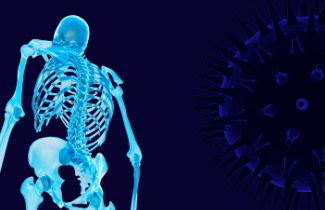 Head, Shoulders, Knees and Toes, Knees and Toes...
Head, Shoulders, Knees and Toes, Knees and Toes...
Your leg bone is connected to your knee bone
Your knee bone is connected to your thigh bone
Your thigh bone is connected to your hip bone…
From a very young age we’ve all been taught basic anatomy. Some of us go on to post-graduate education where the anatomy is taken from basic to advanced and the diagrams and models of skeletons become common place. And while the typical skeletal drawing, Netter’s anatomy book, and the pop art that has assimilated anatomy into pop culture on the surface aren’t fear provoking. Unfortunately, the COVID-19 pandemic, which was at full tilt in the United States in 2020, brought out a different type of skeleton for most; and for a young physician that was incredibly scary.
I had been out of residency and independently practicing as a hospitalist for exactly a year and six months when the United States documented their first official case of the SARS-CoV-2 virus. Thankfully, my central Pennsylvania community had been social distancing since it was incorporated in 1881 (renamed in 1916) with my main hospital immediately servicing a large geographical area but with a population density of 73 people per square mile. Compare that to Philadelphia’s >4,000 per square mile population! As such, my hospital system didn’t see a COVID surge until November 2020 and by then the rules had changed; early intubation was no longer favored, in fact during a time when PPE, ventilators and other resources were being utilized at an alarming rate, no intubation was favored. The heavily favored cocktail of hydroxychloroquine and azithromycin had lost its luster and Remdisivir was no David to the COVID-19 Goliath.
Despite having had strong internal medicine residency training, a type A personality and unwavering perseverance that set me up well for my current hospitalist position, the first surge in central PA (probably the third surge nationally) quickly reminded me of a skeleton I had been dealing with since medical school – fear of the unknown. I watched the virus tear families apart, separate healthcare teams, and tear down not only a patient’s psyche but also the provider’s psyche. I had been taught how to treat, how to stabilize, how to counsel, but never how to live, especially in a time that there was so much death with no proven way to stop it or slow it down.
My hospital, like so many others, implemented visitor restrictions. COVID-19 patients weren’t afforded the luxury of visitors; the hospital was becoming a mirror to the outside world; no visitors, social distance and (of course we always) wash our hands. Not only did I have problems with uncertainty, but families were much more uncertain without being able to see loved ones and having to rely on the nightly news and social media for information about the virus death rates, contagiousness and what could come next.
Like every knee bone that is connected to the thigh bone, which in turn is supported by the hip bone, I turned to family, colleagues and peers for support. Cards from friends on the other side of the state, never-ending family love, and support from colleagues got me through medical school, residency and now a pandemic. While the pandemic hasn’t officially been declared over, if there is another surge in Central PA – heaven forbid – I’ll continue to rely on my support system. And remember, of course, not all skeletons are scary.
